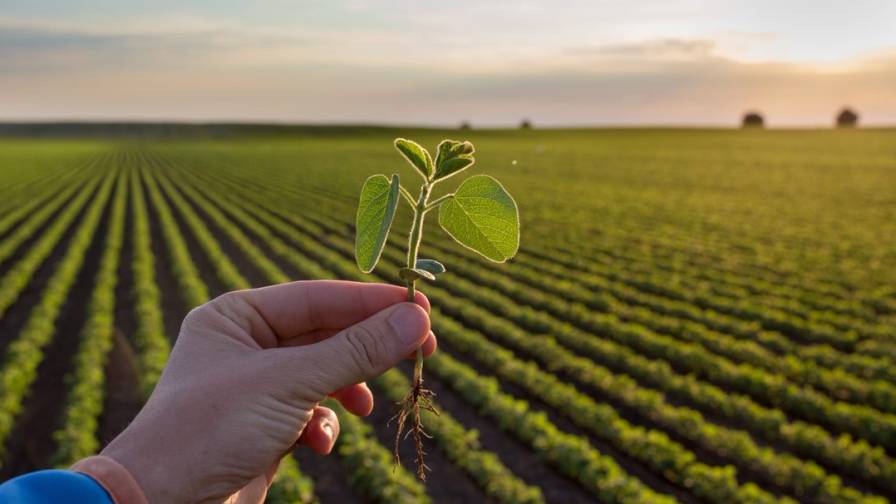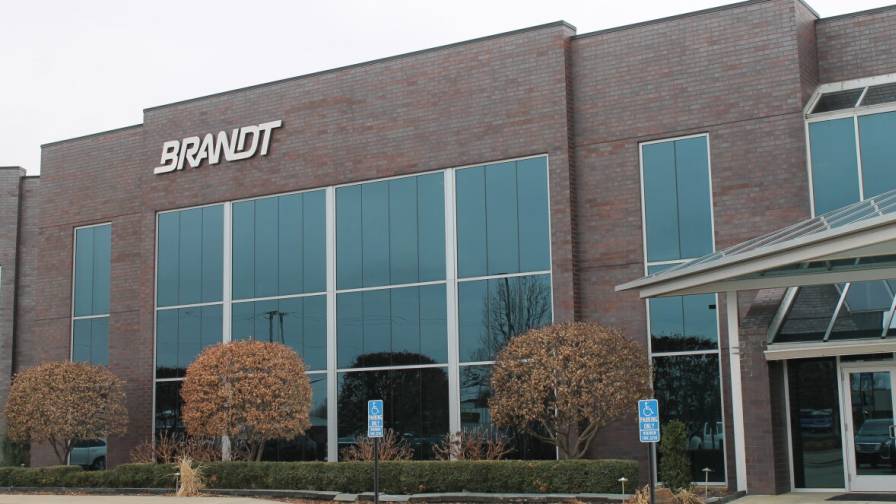Good Crops Begin with Good Seed Treatments
With the headlines around the world regaling us with tales of woe (supply chain disruptions, drought, hurricanes, pandemic, inflation, labor shortages to name a few), it would be easy to believe business everywhere is suffering. For seed treaters that doesn’t seem to be the case.
“As we approach 2023 the current seed treatment industry has never been as strong, the number of application methods available for the producer is vast,” says Vince Wertman, Technical Sales Manager North America, Agrauxine North America. “On farm seed treatment equipment technologies and supporting products are allowing for greater ease of application and prescription like flexibility for seed diseases, pests, and biological products such as rhizobia inoculants.”
Research and development along with new technology allow providers to continually deliver new solutions for retailers to offer their grower-customers.
“We continue to see more biological seed treatments enter the market each year,” David Winston, Key Account Manager, Albaugh. “Growers want to maximize yield on each acre and are looking at many new products/trends to increase their profits. Biologicals have a strong fit in this area. Growers want to plant the seed knowing that the seed company that they’re partnering with has all the bases covered when it comes to seed protection. They may not even realize that the seed treatment program includes a biological, but they understand that it works. Many of these biological products enhance performance and improve return on investment to the grower when paired with synthetic seed treatment technologies.”
At Corteva: “The seed treatment industry continues to grow at a very healthy rate in 2022,” says Prabdeep Bajwa, Vice President, Seed Applied Technologies Portfolio, Corteva Agriscience. “We see continued adoption of new seed treatments as grower awareness of their benefits grows. Farmers are always looking for innovative and performing solutions to overcome the possible seasonal challenges. With population growth and higher input costs, yield and productivity are increasingly important.”
As good as the year has been, there have been some challenges.
“For distribution down to the retailer/seed dealer and out to the grower, supply issues were a reoccurring theme for 2022,” says Blake Murnan, Product Development Manager, CHS Agronomy. “Seed treatment has a relatively small window of time for application before the seed needs to get into the ground. Manufacturing was struggling to keep product in channel due to shortages of tech material, inert ingredients, packaging, and shipping availability.”
As always weather has its own way of challenging growers.
“In 2022, seed treatment was strong,” says Kurt Seevers, Technical Development Manager for Seed Treatments & Inoculants, Verdesian. “As growers are faced with increasing seed costs, they are conscious of the need to get as many seeds to germinate as possible. The cool, wet spring in many areas lead to delays in planting, but soils were still cool even for much of the late planted crops. This will usually result in more seeds being treated to protect from those less than favorable germination conditions. Those fields that did get planted early or near normal timing, were still cool and damp to wet. Seed sat in the ground for weeks in some cases, again making seed treatment highly beneficial.”
Influencers
“There are many factors that are influencing seed treatment use,” Corteva’s Murnan says. “Supply issues were probably the biggest influencer in 2022. However, other factors such as good commodity prices and recent tough environmental conditions over the last couple of years, have growers looking to protect maximum yield potential in their seed investment.”
As technology continues to advance and consumers continue to demand more sustainable solutions, growers are better able to fine-tune their seed prescriptions.
“Expansion of the on-farm applicators by many equipment providers allows for greater flexibility of seed treatment for all the crops grown during the year,” Agrauxine’s Wertman says. “Over the recent years, there has been a define trend to provide complete ‘Rx’-like seed treatment bundles where not only is a fungicide offered but also it is bundled with non-traditional seed treatment products such as nutrient, live biologicals, and growth promoting products like PGRs.”
Even with technological advances that can help growers target specific needs there is always one variable that can override other factors.
“Again, the spring planting season weather conditions were the largest factor influencing seed treatment this year,” Seevers says. “Several new products entering the market may have also contributed to a push for seed treatment at the retail level.
“Due to the cooler and wetter spring in many areas, one would expect seed treatment to be important to most growers affected,” Seevers says. “As seed costs continue to rise, I would expect seed treatment to continue to be important to allow growers to maximize stand establishment by getting as many seeds as possible out of the ground and successfully established.”
With manufacturers focused on delivering more sophisticated products, retailers are able to offer grower-customers more targeted solutions.
“The continuing addition of new products entering the market has driven the demand for seed treatments,” Seevers continues. “A recent emphasis on planter box seed treatments including biostimulants and micronutrients is one area where expansion has occurred rapidly. These products usually are intended to replace the usual seed lubricants such as talc and talc/graphite with a value-added product that provides the same benefits but adds plant growth benefits to what has been a relatively neutral product in the past.”
Like other providers Corteva is focusing on bringing innovative solutions to the market.
“Seed treatment market growth has been driven by new innovative practices, new products and the increasing awareness and adoption of technology,” Bajwa says.
“Biologicals are increasing as are seed applied technologies that deliver higher value to customers, including diamide insecticides, new generation fungicides, and nematicides.
“Farmers continue to face numerous challenges in producing abundant, healthy crops and seed treatments remain an essential tool that enables more sustainable and economical farming,” Bajwa continues. “They help ensure farmers ‘Win the Start’ so that their seed develops into healthy plants that can deliver their full genetic potential.
The additional protection from seed treatments also supports sustainable practices such as no-till, reduced-till, and early planting.”
Expectations
“Our view on seed treatment use is that it will continue to grow,” CHS’s Murnan says. “Not necessarily meaning we’re finding a new untreated acre but being more focused and needed protection or enhancement on the existing acre. For example, we may use newly developed biological or nutritional products that can provide better plant vigor or nutrient uptake.”
It seems that all the seed treatment providers are planning for continued segment growth.
“Seed treatment will continue to expand,” says Wertman. “It offers great agronomic value to help ensure the crop starts with vigor and health. The convenience for the grower to use seed treatment over traditional application methods for crop protections and biologicals is driving the expansion.”
Convenience and efficacy are key.
“As with all companies, Albaugh aims to grow both sales and market share each year,” Winston says. “In 2022 we have been able to do both. The main reason is the addition of two new products to our seed treatment portfolio, Anchor 3L ST (Mefenoxam) and Legend 5L ST (Thiamethoxam). We continue to see growth in the seed treatment market in 2023 and beyond. With the costs of seed, fuel, labor, and chemicals continuing to climb, it’s critically important to protect that seed investment. Seed-applied technology gives growers many benefits to help control costs, from lower active ingredient rates per acres to reduced pre- or post-planting trips across the field, in addition to improving crop yield and quality.”
For the most part, providers were able to deliver the solutions their customers asked for and, on those occasions, when material was unavailable offer alternatives.
“The expectations for seed treatments this year were very much the same as other years — ‘I need an excellent seed treatment, at a good price, and I need it now,’” Murnan says. “From our perspective at CHS, we were able to meet expectations, especially with our STI Customized blending service. We did need to make occasional changes to seed treatment blends based on availability of ingredients that we had on-hand at that time. For formulated package products, there were times that an alternative brand needed to be supplemented or communications needed to go to the end-user that the desired brand is delayed.”
Opportunities
“Agrauxine continues to improve the ease of application for seed treatment products with continued expansion of the product line to be released soon,” Wertman says.
Weather and pests continue to pose challenges for growers. Seed treatment providers continue to deliver solutions.

Almost every county in the U.S. that produces soybeans has been identified as having SCN (soybean cyst nematode) populations, and almost nothing is done to control it, says CHS’s Blake Murnan.
“In the U.S., the most destructive pathogen in soybean production is SCN (soybean cyst nematode),” Murnan says. “It is estimated to cause $1 billion to $1.5 billion in production losses annually. Almost every county in the U.S., that produces soybeans, has been identified as having SCN populations, and almost nothing is done to control it. Fortunately, there are some very good products now available on the market that help protect soybeans from SCN and have significant ROI for the grower. The challenge is to build awareness of this problem and how to handle
the pathogen.”
Final Thoughts
“Seed treatments get the crop up and out of the ground with the best opportunity for health and vigor,” Murnan says. “This allows the crop to take full advantage of all the other inputs that come after germination. Therefore, it is important to find the right combination of seed treatment products along with the correct rates to maximize yield potential.”
There are a great many tools available to growers, but starting with good seeds is definitely a key.
“With all of the factors affecting agriculture around the globe these days, one thing is and always will be a truth,” Seevers says. “If you start the season with a poor stand regardless of the reason, the crop cannot improve, all we can do from there is protect what we have established at the beginning. Because of this, seed and all that we can do to protect the seed remains the most important investment a grower makes every year. Seed treatment provides the best opportunity for the best possible start for every annual crop.”






